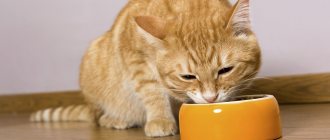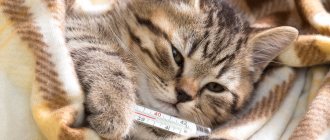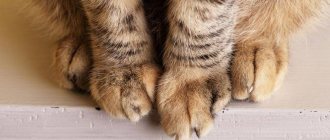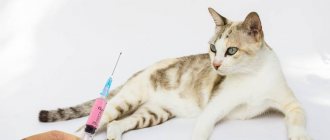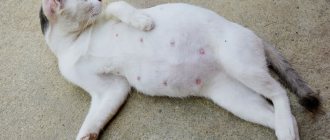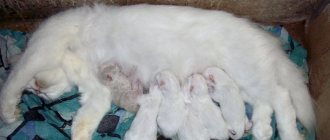If you notice that your cat is bleeding from the vulva, it is understandable that you are worried, as this sign indicates that something is wrong and you are likely facing a health problem.
Cystitis, uterine infections, trauma or tumors may be some of the reasons why your cat is bleeding, but what should we do in these cases? The first step is to immediately contact a veterinary center, since some pathologies that can cause these symptoms can be fatal.
In this article, we will talk about the causes of bleeding in cats, explaining the main reasons why a cat is bleeding and how to treat it. Everything you need to know next, but don't forget: a visit to the vet is essential.
Bloody discharge due to urolithiasis
Urolithiasis (urolithiasis) is a disease accompanied by the formation and deposition of urinary stones or sand in the organs of the urinary system.
Most often, the development of urolithiasis is provoked by an unbalanced diet, when the animal is fed too salty or fatty foods, table scraps, or the pet is kept exclusively on dry food.
Urolithiasis can progress very quickly and often leads to the death of the animal , so if a problem is detected, you should never self-medicate. To minimize your pet's suffering before visiting the veterinarian, you can give him Baralgin M (solution). Dosage: 0.05 mg per 1 kg of animal body weight.
Baralgin M is contraindicated for use if the pet is less than six months old.
Signs of ICD
The development of the disease is indicated by the following symptoms:
- presence of blood in the urine;
- restless behavior of the animal;
- lack of appetite;
- frequent urge to urinate, accompanied by a plaintive meow;
- small amount of urine when urinating;
- apathy.
If you suspect urolithiasis, you should immediately contact a veterinarian. Surgery may be required.
Prevention
As a preventive measure, it is recommended to adjust the animal’s diet. There are some general rules that must be followed when organizing a cat's diet :
- It is necessary to minimize the share of dry industrial food of economy class, because they contain a large amount of salt, which provokes the development of urolithiasis.
- It is recommended to exclude fatty natural products from the diet, including table food.
- Food should contain a minimum amount of sugar, salt, phosphorus and magnesium.
- Your cat should always have fresh water freely available.
The risk of developing the disease can also be reduced by encouraging an active pet lifestyle.
Postpartum recovery period for a mustachioed mother – when should you not worry?
After the birth of fluffies, the cat’s body recovers in about ten days. The pet gains strength and this period is accompanied by discharge, which lasts from one week to three.
Little fluffies are saturated with delicious milk, thereby stimulating the uterus to find its original position and get rid of blood and mucus.
The shade of the discharge may be reddish or brown, but it is normal if there are green inclusions. After about five days, the color of the discharge and its quantity change - it becomes more slimy and transparent, some veins may still be red. The discharge either does not smell of anything or has a characteristic “metallic” odor. If the smell is unpleasant, then you need to take mommy to the veterinarian.
The owner should not worry about red or greenish postpartum discharge from the pet; the main thing is that the new mother does not have a high fever, diarrhea, vomiting or other suspicious symptoms.
The intensity of the discharge and its duration also matter, so you should place a light-colored towel under your pet so that any changes can be clearly seen on it. Change the litter every day to prevent infection. If you notice heavy discharge over a long period of time, this is a dangerous sign of an internal inflammatory process.
Vaginitis
Vaginitis is an inflammation of the vaginal mucosa.
Many owners mistake vaginitis for estrus due to the fact that cats suffering from this disease are attracted to males. The cause of the disease is most often an unsuccessful mating.
Symptoms of the disease:
- bleeding from the vagina;
- frequent urination;
- swelling of the vulva.
If you suspect vaginitis, it is recommended to wash your cat's vagina with a chamomile solution.
If this bleeding does not stop, you should contact a specialist as soon as possible.
Dangerous symptoms
If a cat’s blood is released from the vagina in clots due to the progression of dangerous disorders in the body, the following pathological symptoms will be additionally disturbing:
- decreased animal activity;
- loss of appetite or complete refusal of food and water;
- frequent or infrequent painful urination with blood;
- thorough licking of the anterior passage;
- increased body temperature;
- tachycardia, breathing problems.
Acute urethritis in a cat is accompanied by severe polyuria and irrepressible thirst. If the owner notices that blood or purulent fluid is flowing from under the tail, this symptom indicates the development of complications that cannot be dealt with without medical help.
Pyometra
Among the most common diseases of cats with bloody discharge is pyometra, a form of purulent endometritis in which pus accumulates in the uterine cavity. The disease is most often provoked by rash actions of the owners themselves, namely:
- abuse of hormonal drugs during estrus;
- uncontrolled mating;
- infection in the vagina during childbirth.
There are two types of pyometra:
- Open form - blood clots come out of the vagina. The cat licks itself frequently, approximately every 15-20 minutes. The animal's temperature rises, the cat often drinks water.
- Closed form - no discharge visible, because blood accumulates in the uterine cavity. Symptoms of the closed form of pyometra: enlarged, tight abdomen, frequent urination, apathy, rapid breathing.
Of these two forms, the second poses the greatest threat to health, because. excessive accumulation of pus in the uterus can lead to the death of the animal.
What you can encounter and what the owner should be afraid of
To begin with, urine is the fluid that is excreted from the body as a result of the work of the kidneys, ureter and bladder. Along with it, various toxins, micro- and macroelements go away. Normally, it should be transparent or light yellow.
Diuresis in a healthy pet is 1-2 ml/kg/h. A minimum of 1 ml should be released.
For example, a pet weighs 4 kg, let’s calculate (1 ml x 4 kg x 24 hours = 96 ml), therefore, it should release approximately 96 ml per day.
Discharge after pregnancy
The presence of bloody discharge in a pregnant cat is completely normal when it is presented as transparent, homogeneous, odorless clots.
However, prolonged discharge of purulent-bloody discharge with a greenish tint after birth indicates possible inflammation of the animal’s genital organs.
It often happens that the fetus gets stuck in the cat's womb, or the placenta for some reason does not come out of the uterus, as a result of which the process of rotting begins. In both cases, surgical removal of the foreign object will be required, because prolonged decomposition inside the animal's body can lead to intoxication of the pet.
Sometimes bloody discharge during the postpartum period may be just remnants of the placenta. Usually the placenta is completely expelled from the uterus within 3 hours after birth, and the number of membranes should correspond to the number of kittens. In this case, surgical intervention is not required.
How can you tell if an animal is unhealthy?
The phenomenon discussed in the article does not always indicate the presence of pathology. However, the presence of the disease may be indicated by the following accompanying symptoms:
- Reducing the pet's activity.
- Cat's refusal to eat.
- Frequent, infrequent or difficult urine output.
- Licking the perineal area.
- Heat.
- Increased heart rate, breathing problems.
If such signs occur, you urgently need to show the animal to a specialist who will carry out the necessary diagnostics. Examination using ultrasound and x-rays, laboratory tests of biological material will help determine what is causing the appearance of bloody discharge. If you consult a doctor in a timely manner, your pet can usually be cured.
After mating
Bloody discharge from the loop may appear in a cat after mating in the event of resorption of the fetus, which can occur at any stage of pregnancy. In most cases, the animal’s body independently copes with the problem , expelling the dead fetuses from the womb, but they can also remain in the uterus for quite a long time.
As a result, fruit rot begins, which can lead to inflammation of the cat’s genitals and blood poisoning. Resorption of the fruit is accompanied by bleeding with pus and mucus. Blood clots have a rather pungent odor.
A possible cause of bleeding after mating can also be an ectopic pregnancy. In this case, urgent assistance from a veterinarian is necessary—delayed surgical intervention can lead to the death of the pet.
A set of measures to prevent undesirable consequences of childbirth
When preparing for childbirth, even experienced animals experience fear and anxiety. The nervousness of the cat's mother can negatively affect the birth process.
You need to observe the animal unobtrusively, trying not to disturb
To reduce the likelihood of complications, it is necessary to prepare in advance for your pet a place that meets the following requirements:
- Accessibility for cleaning. You need to be able to clean the cat’s “nest” and at the same time disturb the mother and offspring as little as possible. A good option would be a mattress covered with an absorbent diaper.
- Space limitation. While crawling, newborns can fall off the bedding, and the kitten’s squeak unnerves the pet. If labor is not completed, the reaction to the baby's crying can cause complications. A large box or installation of limiting sides will do.
- No drafts. The immunity of both mother and cubs is still weak.
- Removing strangers. Extra people make the animal worry and try to hide the born offspring. Inexperienced cats can accidentally crush babies. In a calm environment, the pet will relax, give birth and settle down so that it is more convenient for newborns to suckle.
Be sure to read:
Can a cat give birth to one kitten if the fetus is in the birth canal, what to do?
A cat giving birth should have a bowl and a toilet next to the “nest”. The birth process can take several days and the cat's mother needs to ensure that her natural needs are met.
Video “Birth of a kitten”
We do not recommend watching this video for impressionable or faint-hearted people - it shows the process of giving birth to a kitten and how the cat cares for it immediately after birth.
Was this article helpful?
Thank you for your opinion!
The article was useful. Please share the information with your friends.
Yes (100.00%)
No
X
Please write what is wrong and leave recommendations on the article
Cancel reply
Rate the benefit of the article: Rate the author ( 3 votes, average: 5.00 out of 5)
Discuss the article:
Care, maintenance and treatment of your pet
In order for treatment measures to bring positive results more quickly, owners need to provide the cat with proper care:
- Provide a secluded place for the animal, put a disposable sheet on the bed and change it regularly when it gets dirty.
- The room where the sick cat is located must be warm and free of drafts, and it must be ventilated regularly.
- During treatment, it is forbidden to let your pet go outside; its communication with other pets should be limited.
- The cat must have constant access to drinking water. If the animal refuses to drink or is too weak, you need to give it water yourself using a syringe, after removing the needle.
- During the illness, the animal should receive nutritious and easily digestible food. These can be meat broths, to which chopped meat, fermented milk products, cereals and vegetables are added in small quantities. On the advice of a veterinarian, you can purchase special medicated food so that the animal gains strength faster.
To protect your pet from diseases that lead to bleeding, you must adhere to the following preventive measures:
- If the cat is not intended for breeding, it makes sense to sterilize the pet. This will protect her from many diseases that occur in the genitourinary system. After the procedure, the cat should be regularly shown to the veterinarian for an ultrasound, this will help to better monitor the animal’s health.
- Get all necessary vaccinations and antihelminthic treatment in a timely manner to maintain the body's defenses.
- For mating, choose a healthy male cat; the owners of the male must document this.
- When giving birth to a cat, use sterile consumables and thoroughly treat your hands with antiseptics.
- If any unusual discharge occurs, you should take your cat to the veterinarian as soon as possible.
The measures described above will help not only prevent the development of the disease, but also, if necessary, show the cat to a specialist as soon as possible without wasting time.
Bloody discharge accompanied by a significant deterioration in the animal’s condition is a formidable sign indicating the development of severe pathology. There is no need to try to find the cause on your own, but take the cat to the veterinary clinic as soon as possible for examination and treatment.
Mr. Cat explains: 5 rules for collecting urine
This is the main thing you need to know when collecting urine so that the analysis is most accurate:
- Prepare a cat litter box for collection. Initially disinfect and wash.
- Do not fill it with fillers.
- If the cat refuses to go to an empty tray, you can buy special mixtures in stores that are similar to fillers for collecting tests.
- After the animal has done its business, you need to pour the contents of the tray into a special container for collecting samples.
- Be sure to submit for analysis within 2-3 hours.
